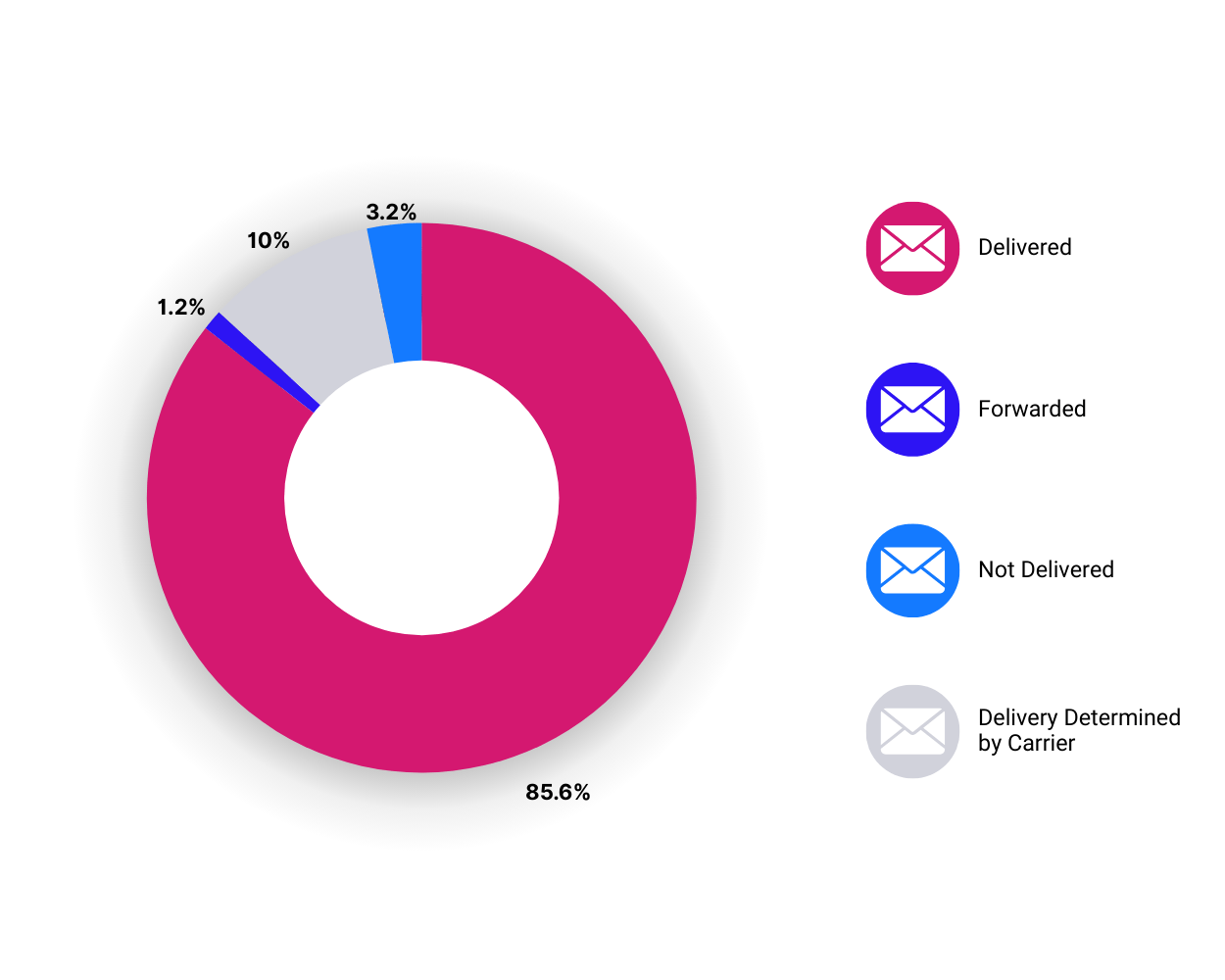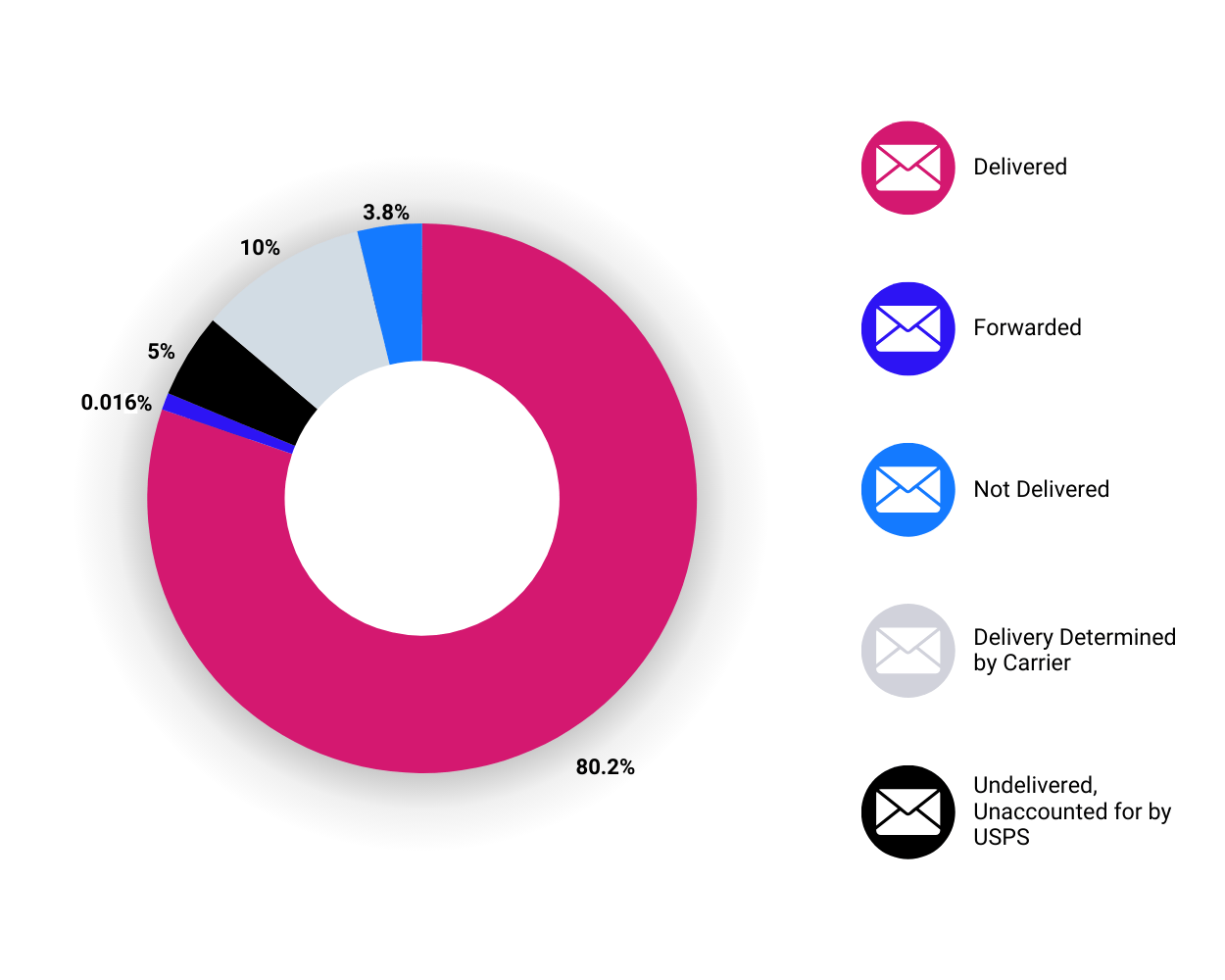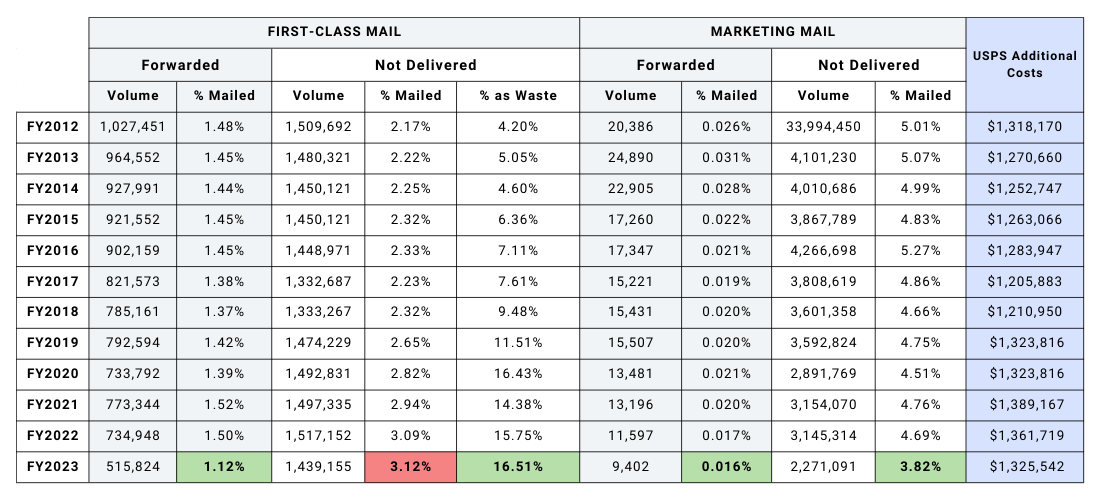2023 USPS® UAA Statistics
Understanding trends in Undeliverable-As-Addressed Mail
GrayHair applies our data-centric best practices approach to minimize undeliverable mail, reduce costs and increase customer satisfaction and response rates for our clients. Adam Collinson, GrayHair’s Director of Address Intelligence, analyzed the past 15+ years of UAA mail statistics from PostalPro to provide insight into what’s behind the 2023 results that highlight the still significant challenges and opportunities to reduce UAA mail.

Product Quality Index
Energy Generation
What is UAA Mail?
Undeliverable-as-Addressed (UAA mail) is all mail that cannot be delivered to the name and address specified on a mailpiece. All UAA mail then must be forwarded, returned to sender or properly treated as waste, depending on the class of mail and ancillary service endorsement on the mailpiece.
UAA Mail affects the timeliness of mail delivery, impacts postal operations for your organization and creates additional costs for the USPS.
Mail may be categorized as UAA due to various reasons, such as:
- The individual, family, or business to which it is addressed has relocated
The address is incomplete, incorrect or simply invalid for mail delivery
- The addressee is unknown at the address or deceased
- The addressee refuses or fails to claim the mail
- Production issues with the piece (such as illegible or postage not paid)
USPS 2023 UAA Statistics
First-Class Mail®

Marketing Mail®

Trends in UAA Mail – 10 Year View

“Our clients have markedly lower UAA Rates than the industry average. Mailers who apply GrayHair's address quality best practices and invest in their postal operations significantly outperform these numbers.”
Director of Address Intelligence, GrayHair Software
What is the industry impact of UAA Mail?
Undeliverable mail can result in revenue loss, customer dissatisfaction, lost opportunities to reach your audience, and potential fraud issues.
UAA Mail cost the USPS roughly $1.3 billion in 2023 and an estimated $20 billion to the mailing industry as a whole. The average industry impact of just one piece of UAA mail is $3.50.
What distinguishes UAA mail in terms of forwarding, return to sender, and treated as waste?
Undeliverable mail falls into three categories: forwarded, return to sender, or treated as waste. The cost to the USPS for the additional processing of UAA mail varies significantly from if they are allowed to treat as waste, to forwarding the piece, to returning the piece to the sender. These costs have to be covered via postage fees and postage rates.
For the mailer, forwarded mail means a delay in delivery from a matter of days to weeks. Return to sender and treated as waste reflects a lost opportunity and wasted costs. UAA pieces that the Carrier figured out and delivered are also a risk – with the next piece, will the same carrier be doing that route that day and will they have the time to work the pieces with the deficient address information.
First-Class vs. Marketing Mail
How do First-Class and Marketing Mail UAA rates differ?
First-Class Mail, used for statements and critical notices, tends to have lower undeliverable rates. Companies ensure data cleanliness as they interact with established customers. On the other hand, marketing mail, tailored for prospects, faces higher undeliverable rates due to process and data quality issues. The overall decrease in UAA Marketing Mail in 2023 includes an increase in non – Change of Address (COA) issues that is masked by the greater impact of there being fewer COA’s due to the housing market. While marketing mail experienced lower undeliverable rates in 2023, the numbers still indicate marketers are still incurring increased costs and decreased response rates.
Some UAA Marketing Mail (around 5%) is not counted by the USPS nor reported back to the mailer, posing a risk to mailers with future communications.
Additionally, some UAA mail gets delivered thanks to the knowledge and extra effort of USPS Carriers and Clerks. For example, approximately 1 in 200 US addresses are invalid for mail delivery, yet 75-80% of pieces to these addresses are delivered. Recent changes have increased mailing costs for these pieces, and mailers often lack Change of Address information when these recipients move. Obtaining accurate mailing addresses is crucial for timely delivery and staying informed about recipient relocations.
Why has the rate of forwarded mail decreased in 2023?
The percentage of forwarded mail for both First-Class and Marketing Mail was at an all-time low in 2023. This improvement can be attributed to multiple factors. The USPS made changes to the way Change of Address records are filed, ensuring higher-quality new addresses. The housing market slowdown also played a significant role, with fewer people changing addresses.
Why do we see differences in forwarding between First-Class and Marketing Mail?
First-Class Mail usually gets forwarded for the first 12 months, ensuring that the piece eventually reaches the intended recipient. In contrast, Marketing Mail, by default, doesn’t get forwarded. Mailers must specifically request forwarding, incurring extra costs. Consequently, Marketing Mail sees fewer pieces forwarded as most pieces with a Change of Address are treated as waste. Additionally, Marketing Mail with alternative addressing (“Or Current Resident”) is not subject to forwarding.
When all other UAA rates have decreased in 2023, why are First-Class undeliverable rates the highest out of the 10-year window?
1) Stagnant address data, neglect in handling bad addresses, and the influx of potentially inaccurate addresses from new business have led to sustained elevated undeliverable rates.
2) Our routine performance reviews of client data and operations revealed notable jumps in Undeliverable As Addressed (UAA) rates for both First-Class and Marketing mailers. This spike, particularly for addresses with deficiencies, stems from USPS staffing challenges, turnover, and efforts to minimize carrier time. These changes pose challenges for First-Class mailers, limiting their ability to swiftly adapt and rectify deficient addresses, thereby amplifying undeliverable rates.
What are the financial implications of undeliverable First-Class Mail?
Undeliverable First-Class Mail carries substantial financial implications.
- For the USPS, returning it to the sender costs USPS an additional 58 cents per piece and forwarding costs an additional 29 cents while treating it as waste costs only 14 cents.
- For the mailer, in addition to the initial costs of production and postage, there is the cost of processing what was returned by the USPS – receive the piece, record and process based on why it was undeliverable, and securely destroy the mailpieces containing sensitive information, such as credit card statements or healthcare documents.
A cost-effective solution is the USPS Secure Destruction service, saving both mailers and USPS expenses. Instead of physical return, the reason the piece was not deliverable is communicated to the mailer within 1-2 days via Address Change Service (ACS™), leading to faster corrective actions and reduced repeated Return to Sender (RTS) mail. The USPS Secure Destruction service comes at no extra charge for the mailer.

The Experts Take: How Mailers Can Minimize UAA Mail
“Discovering strategies to reduce your undeliverable rates is necessary for mailers sending both First-Class and Marketing Mail alike. This means understanding current processes and UAA rates as well as what tools and data are available and applicable to your operations.
For marketing mailers, it is crucial to identify the most optimal pieces for mailing. This not only reduces USPS costs but also boosts response rates, unlocking the potential for campaign success and new opportunities.
For First-Class mailers, reducing undeliverable mail to minimize delays and instances of incorrect recipients is the key. Beyond the financial impact on mailers, mitigating fraud risks is crucial. The ripple effect extends to safeguarding customer relationships and elevating overall customer experience.“
– Adam Collinson
Director of Address Intelligence, GrayHair Software
